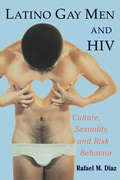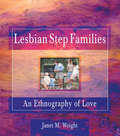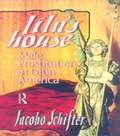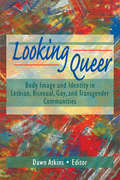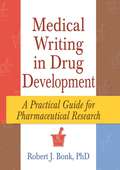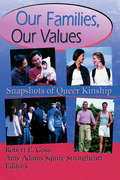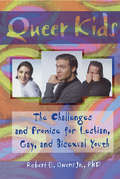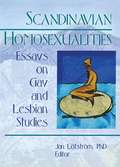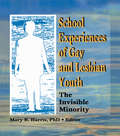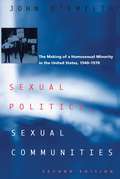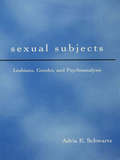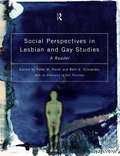- Table View
- List View
Latino Gay Men and HIV: Culture, Sexuality, and Risk Behavior
by Rafael M. DiazWith research based on focus group and individual interviews in the United States, as well as a thorough and integrative review of the current literature, Latino Gay Men and HIV discusses the six main sociocultural factors in Latino communities -- machismo, homophobia, family cohesion, sexual silence, poverty and racism--which undermine safe sex practices. In an attempt to explain the alarmingly high incidence of unprotected intercourse in this population, this in-depth cultural and psychological analysis shows how an apparent incongruence between knowledge or intention and behavior can possess its own sociocultural logic and meaning.
Latino Gay Men and HIV: Culture, Sexuality, and Risk Behavior
by Rafael M. DiazWith research based on focus group and individual interviews in the United States, as well as a thorough and integrative review of the current literature, Latino Gay Men and HIV discusses the six main sociocultural factors in Latino communities -- machismo, homophobia, family cohesion, sexual silence, poverty and racism--which undermine safe sex practices. In an attempt to explain the alarmingly high incidence of unprotected intercourse in this population, this in-depth cultural and psychological analysis shows how an apparent incongruence between knowledge or intention and behavior can possess its own sociocultural logic and meaning.
Lesbian Step Families: An Ethnography of Love
by Ellen Cole Esther D Rothblum Janet M WrightLesbian Step Families: An Ethnography of Love explores five lesbian step families’definitions of the step parent role and how they accomplish parenting tasks, cope with homophobia, and define and interpret their experiences. An intensive feminist qualitative study, the book offers guidelines for counselors and lesbian step families for creating healthy, functioning family structures and environments. It is the first book to concentrate exclusively on lesbian step families rather than on lesbian mothering in general.In Lesbian Step Families: An Ethnography of Love, you’ll explore in detail the different kinds of step relationships that are developed and what factors may lead to the different types of step mothering in lesbian step families. The book helps you understand these relationships and parent roles through in-depth discussions of: how a step mother and legal mother who live together negotiate and organize parenting and homemaking tasks how members of lesbian step families define and create the step mother role strategies family members use to define and cope with oppression how sexism is transmitted within the family and how mothering may limit and/or contribute to female liberation the opinions and viewpoints of the children of these families The findings in Lesbian Step Families: An Ethnography of Love challenge traditional views of mothering and fathering as gender and biologically based activities; they indicate that lesbian step families model gender flexibility and that the mothers and step mothers share parenting--both traditional mothering and fathering--tasks. This allows the biological mother some freedom from motherhood as well as support in it. With insight such as this, you will be prepared to help a client, a loved one, or yourself develop and maintain healthy family relationships.
Lesbian Step Families: An Ethnography of Love
by Ellen Cole Esther D Rothblum Janet M WrightLesbian Step Families: An Ethnography of Love explores five lesbian step families’definitions of the step parent role and how they accomplish parenting tasks, cope with homophobia, and define and interpret their experiences. An intensive feminist qualitative study, the book offers guidelines for counselors and lesbian step families for creating healthy, functioning family structures and environments. It is the first book to concentrate exclusively on lesbian step families rather than on lesbian mothering in general.In Lesbian Step Families: An Ethnography of Love, you’ll explore in detail the different kinds of step relationships that are developed and what factors may lead to the different types of step mothering in lesbian step families. The book helps you understand these relationships and parent roles through in-depth discussions of: how a step mother and legal mother who live together negotiate and organize parenting and homemaking tasks how members of lesbian step families define and create the step mother role strategies family members use to define and cope with oppression how sexism is transmitted within the family and how mothering may limit and/or contribute to female liberation the opinions and viewpoints of the children of these families The findings in Lesbian Step Families: An Ethnography of Love challenge traditional views of mothering and fathering as gender and biologically based activities; they indicate that lesbian step families model gender flexibility and that the mothers and step mothers share parenting--both traditional mothering and fathering--tasks. This allows the biological mother some freedom from motherhood as well as support in it. With insight such as this, you will be prepared to help a client, a loved one, or yourself develop and maintain healthy family relationships.
Lila's House: Male Prostitution in Latin America
by Jacobo SchifterLila's House: Male Prostitution in Latin America presents insight into male prostitution in a truly global array of Latin American countries. This study focuses on a very specific sexual culture within the realm of male prostitution: the young men of a lower/middle-class brothel catering to a broad range of clients. You will explore the culture of juvenile prostitution and learn from the immediate intervention program that was implemented. Twenty-five young men between the ages of 13 and 27 were interviewed for this study. They share with you their views on:sexual initiationsexual definitionsexual orientationlovedrug useprostitutionfamily relationshipsrelationships with men and womenThe young men interviewed for this study are in serious danger of being exposed to the AIDS virus and of becoming addicted, if they are not already, to cocaine, crack, or alcohol. Those conducting the study initiated a campaign to supply condoms and raise the young men's awareness about AIDS and drugs and began an immediate support program. The project resulted in the establishment, in June 1997, of an alternative home for juvenile prostitutes, which offers various opportunities for education and work.
Lila's House: Male Prostitution in Latin America
by Jacobo SchifterLila's House: Male Prostitution in Latin America presents insight into male prostitution in a truly global array of Latin American countries. This study focuses on a very specific sexual culture within the realm of male prostitution: the young men of a lower/middle-class brothel catering to a broad range of clients. You will explore the culture of juvenile prostitution and learn from the immediate intervention program that was implemented. Twenty-five young men between the ages of 13 and 27 were interviewed for this study. They share with you their views on:sexual initiationsexual definitionsexual orientationlovedrug useprostitutionfamily relationshipsrelationships with men and womenThe young men interviewed for this study are in serious danger of being exposed to the AIDS virus and of becoming addicted, if they are not already, to cocaine, crack, or alcohol. Those conducting the study initiated a campaign to supply condoms and raise the young men's awareness about AIDS and drugs and began an immediate support program. The project resulted in the establishment, in June 1997, of an alternative home for juvenile prostitutes, which offers various opportunities for education and work.
Looking Queer: Body Image and Identity in Lesbian, Bisexual, Gay, and Transgender Communities
by Dawn AtkinsLooking Queer: Body Image in Lesbian, Bisexual, Gay, and Transgender Communities contains research, firsthand accounts, poetry, theory, and journalistic essays that address and outline the special needs of sexual minorities when dealing with eating disorders and appearance obsession. Looking Queer will give members of these communities hope, insight, and information into body image issues, helping you to accept and to love your body. In addition, scholars, health care professionals, and body image activists will not only learn about queer experiences and identity and how they affect individuals, but will also understand how some of the issues involved affect society as a whole. Dismantling the myth that body image issues affect only heterosexual women, Looking Queer explores body issues based on gender, race, class, age, and disability. Furthermore, this groundbreaking book attests to the struggles, pain, and triumph of queer people in an open and comprehensive manner. More than 60 contributors provide their knowledge and personal experiences in dealing with body image issues exclusive to the gay and transgender communities, including: exploring and breaking down the categories of gender and sexuality that are found in many body image issues finding ways to heal yourself and your community discovering what it means to “look like a dyke” or to “look gay” fearing fat as a sign of femininity determining what race has to do with the gay ideal discussing the stereotyped ”double negative”--being a fat lesbian learning strategies of resistance to societal ideals critiquing ”the culture of desire” within gay men’s communities that emphasizes looks above everything elseRevealing new and complex dimensions to body image issues, Looking Queer not only discusses the struggles and hardships of gay, lesbian, bisexual, and transgendered persons, but looks at the processes that can lead to acceptance of oneself. Written by both men and women, the topics and research in Looking Queer offer insight into the lives of people you can relate to, enabling you to learn from their experiences so you, too, can find joy and happiness in accepting your body.Visit Dawn Atkin’s website at: http://home.earthlink.net/~dawn_atkins/
Looking Queer: Body Image and Identity in Lesbian, Bisexual, Gay, and Transgender Communities
by Dawn AtkinsLooking Queer: Body Image in Lesbian, Bisexual, Gay, and Transgender Communities contains research, firsthand accounts, poetry, theory, and journalistic essays that address and outline the special needs of sexual minorities when dealing with eating disorders and appearance obsession. Looking Queer will give members of these communities hope, insight, and information into body image issues, helping you to accept and to love your body. In addition, scholars, health care professionals, and body image activists will not only learn about queer experiences and identity and how they affect individuals, but will also understand how some of the issues involved affect society as a whole. Dismantling the myth that body image issues affect only heterosexual women, Looking Queer explores body issues based on gender, race, class, age, and disability. Furthermore, this groundbreaking book attests to the struggles, pain, and triumph of queer people in an open and comprehensive manner. More than 60 contributors provide their knowledge and personal experiences in dealing with body image issues exclusive to the gay and transgender communities, including: exploring and breaking down the categories of gender and sexuality that are found in many body image issues finding ways to heal yourself and your community discovering what it means to “look like a dyke” or to “look gay” fearing fat as a sign of femininity determining what race has to do with the gay ideal discussing the stereotyped ”double negative”--being a fat lesbian learning strategies of resistance to societal ideals critiquing ”the culture of desire” within gay men’s communities that emphasizes looks above everything elseRevealing new and complex dimensions to body image issues, Looking Queer not only discusses the struggles and hardships of gay, lesbian, bisexual, and transgendered persons, but looks at the processes that can lead to acceptance of oneself. Written by both men and women, the topics and research in Looking Queer offer insight into the lives of people you can relate to, enabling you to learn from their experiences so you, too, can find joy and happiness in accepting your body.Visit Dawn Atkin’s website at: http://home.earthlink.net/~dawn_atkins/
Medical Writing in Drug Development: A Practical Guide for Pharmaceutical Research
by Robert J BonkA guide through the maze of the pharmaceutical research and development process, Medical Writing in Drug Development fills a gap in the libraries of technical writers, college instructors, and corporate professionals associated with the pharmaceutical process. As it discusses critical information, such as strategies and techniques pivotal to crafting documents for drug development, it also overviews drug research, document types, the roles of professional writers, and information technology. In no time at all, you will be creating persuasive technical documents, building complex facts into coherent messages, and contributing to the effective marketing of new products with promotional pieces that meet legal and ethical standards.Medical Writing in Drug Development helps medical writers and scientific, regulatory, and marketing professionals develop a working knowledge of the technical documents crucial to successful drug research. New and seasoned professional writers alike will benefit from the book's detailed discussions of:using abstracts, slides, and posters to present up-to-the-minute researchhow patient-education materials, health-economic assessments, and electronic journals provide ongoing challenges in medical writinga dossier approach that expedites regulatory submissions for international drug developmentstructural constraints and rhetorical approaches toward regulatory documentspresenting intricate information in scientifically unbiased, yet technically convincing languagethe effects of electronic publishing, computer graphics, and related technology on the practice of medical writing within pharmaceutical researchPractical as a foundation text for undergraduate, graduate, and certificate programs in pharmaceutical or medical technical writing, Medical Writing in Drug Development will help you develop practical strategies for handling journal manuscripts, conference materials, and promotional pieces. No other text will clarify the main aspects of the pharmaceutical research and development process while offering you insight on the key issues dominating the healthcare arena.
Medical Writing in Drug Development: A Practical Guide for Pharmaceutical Research
by Robert J BonkA guide through the maze of the pharmaceutical research and development process, Medical Writing in Drug Development fills a gap in the libraries of technical writers, college instructors, and corporate professionals associated with the pharmaceutical process. As it discusses critical information, such as strategies and techniques pivotal to crafting documents for drug development, it also overviews drug research, document types, the roles of professional writers, and information technology. In no time at all, you will be creating persuasive technical documents, building complex facts into coherent messages, and contributing to the effective marketing of new products with promotional pieces that meet legal and ethical standards.Medical Writing in Drug Development helps medical writers and scientific, regulatory, and marketing professionals develop a working knowledge of the technical documents crucial to successful drug research. New and seasoned professional writers alike will benefit from the book's detailed discussions of:using abstracts, slides, and posters to present up-to-the-minute researchhow patient-education materials, health-economic assessments, and electronic journals provide ongoing challenges in medical writinga dossier approach that expedites regulatory submissions for international drug developmentstructural constraints and rhetorical approaches toward regulatory documentspresenting intricate information in scientifically unbiased, yet technically convincing languagethe effects of electronic publishing, computer graphics, and related technology on the practice of medical writing within pharmaceutical researchPractical as a foundation text for undergraduate, graduate, and certificate programs in pharmaceutical or medical technical writing, Medical Writing in Drug Development will help you develop practical strategies for handling journal manuscripts, conference materials, and promotional pieces. No other text will clarify the main aspects of the pharmaceutical research and development process while offering you insight on the key issues dominating the healthcare arena.
Our Families, Our Values: Snapshots of Queer Kinship
by Robert Goss Amy Adams Squire StrongheartOur Families, Our Values challenges both the gay community and American society to examine carefully the meaning of family values and the nature of social institutions such as marriage and the family. It asks you provoking, even disturbing, questions such as: “Is it prudent for members of the Lavender community to mimic heterosexual marriage or define personal relations networks as families, when these institutions are rapidly collapsing?” “Are we attempting to mainstream American society into accepting different views of marriage and families?” “Are we subscribing to notions of sexual property that are inherent to the marriage ceremony and the institution of marriage, when we choose to be married?” Despite the complexities of this issue, marriage constitutes a privileged position in western society, and, as this book shows you, without the legal recognition of same-sex marriages, there are many fundamental rights, as well as privileges, denied to gay, lesbian, bisexual, and transgendered persons.As Our Families, Our Values turns upside-down the widely accepted notion that only heterosexual people are entitled to get married, have sex, and rear children, you gain insight into personal struggles and affirmations that testify to the spirituality, procreativity, and wholesomeness of the diverse relationships of the Lavender community. You will also learn about various ongoing efforts to give religious pride to the various configurations of gay relationships, families, and values and the disruption of popular interpretations of the Scriptures that have been used to justify the oppression of sexual minorities. This book will intrigue you over and over again, as you read about: value systems transphobia equal marriage rights Buddhism’s rejection of “traditional family values” Brazil’s sex-positive culture differences between gay male social formations and families choosing a language and terms that empower sexual minorities and the essence of the liberation movement sex as communion relationships based on nurture, not transactionDesigned for academics and students of religion, pastors, priests, rabbis, and lay readers alike, Our Families, Our Values is a multifaceted view of the gay community’s response to the public controversy over gay marriage, adoption, and foster care rights. Ideal as a textbook for courses in sexuality, theology, sociology, women’s studies, and gay and lesbian studies, this book will both inform you and delight you as it reminds you that same-sex unions bring much cause for celebration and that religion and homosexuality are not mutually exclusive.
Our Families, Our Values: Snapshots of Queer Kinship
by Robert Goss Amy Adams Squire StrongheartOur Families, Our Values challenges both the gay community and American society to examine carefully the meaning of family values and the nature of social institutions such as marriage and the family. It asks you provoking, even disturbing, questions such as: “Is it prudent for members of the Lavender community to mimic heterosexual marriage or define personal relations networks as families, when these institutions are rapidly collapsing?” “Are we attempting to mainstream American society into accepting different views of marriage and families?” “Are we subscribing to notions of sexual property that are inherent to the marriage ceremony and the institution of marriage, when we choose to be married?” Despite the complexities of this issue, marriage constitutes a privileged position in western society, and, as this book shows you, without the legal recognition of same-sex marriages, there are many fundamental rights, as well as privileges, denied to gay, lesbian, bisexual, and transgendered persons.As Our Families, Our Values turns upside-down the widely accepted notion that only heterosexual people are entitled to get married, have sex, and rear children, you gain insight into personal struggles and affirmations that testify to the spirituality, procreativity, and wholesomeness of the diverse relationships of the Lavender community. You will also learn about various ongoing efforts to give religious pride to the various configurations of gay relationships, families, and values and the disruption of popular interpretations of the Scriptures that have been used to justify the oppression of sexual minorities. This book will intrigue you over and over again, as you read about: value systems transphobia equal marriage rights Buddhism’s rejection of “traditional family values” Brazil’s sex-positive culture differences between gay male social formations and families choosing a language and terms that empower sexual minorities and the essence of the liberation movement sex as communion relationships based on nurture, not transactionDesigned for academics and students of religion, pastors, priests, rabbis, and lay readers alike, Our Families, Our Values is a multifaceted view of the gay community’s response to the public controversy over gay marriage, adoption, and foster care rights. Ideal as a textbook for courses in sexuality, theology, sociology, women’s studies, and gay and lesbian studies, this book will both inform you and delight you as it reminds you that same-sex unions bring much cause for celebration and that religion and homosexuality are not mutually exclusive.
Queer Kids: The Challenges and Promise for Lesbian, Gay, and Bisexual Youth
by Robert E OwensPacked to the hilt with living narratives, scholarly research, and problem-solution scenarios, Queer Kids: The Challenges and Promise for Lesbian, Gay, and Bisexual Youth examines the unique challenges faced by today’s homosexual young adults. You’ll learn what modern-day queer kids do to cope, survive, and find understanding in a world riddled with homophobic intolerance. Queer Kids is a lens of clarity that will help the average straight adult--and maybe even the average gay adult--see things from a kid’s point of view. Its detail-oriented, well-wrought chapters will provide you with literally hundreds of stories of young people who are trying to define themselves sexually and emotionally in a society of criss-crossing judgment, stereotyping, anger, and expectation. Aimed at three target groups--counselors, parents, and youth--this book introduces you to a variety of interesting kids, offers you a look at the process of coming out, and helps you grasp the experience of queer identification. Specifically, you’ll read about: queer kids and their families and peers the medical/health care profession’s impact on queer kids the teachers and counselors of gay, lesbian, and bisexual youth how to alleviate harrassment, abuse, withdrawal, and loneliness the effects of familial denial, prejudiced counselors, and standoffish gay adultsBeing a kid is tough--but being a queer kid can be even tougher. Fortunately, Queer Kids is available for students, ministers, teachers, youth- and health-care workers, and especially the friends and families of teens who are working through the personal turbulence that too often accompanies sexual and emotional definition. Guided by its upfront approach and practical resource list of written, computer, and telephone aids, you’ll see that a solution is not as distant as you think. Read it, and relearn what it means to be a kid again.
Queer Kids: The Challenges and Promise for Lesbian, Gay, and Bisexual Youth
by Robert E OwensPacked to the hilt with living narratives, scholarly research, and problem-solution scenarios, Queer Kids: The Challenges and Promise for Lesbian, Gay, and Bisexual Youth examines the unique challenges faced by today’s homosexual young adults. You’ll learn what modern-day queer kids do to cope, survive, and find understanding in a world riddled with homophobic intolerance. Queer Kids is a lens of clarity that will help the average straight adult--and maybe even the average gay adult--see things from a kid’s point of view. Its detail-oriented, well-wrought chapters will provide you with literally hundreds of stories of young people who are trying to define themselves sexually and emotionally in a society of criss-crossing judgment, stereotyping, anger, and expectation. Aimed at three target groups--counselors, parents, and youth--this book introduces you to a variety of interesting kids, offers you a look at the process of coming out, and helps you grasp the experience of queer identification. Specifically, you’ll read about: queer kids and their families and peers the medical/health care profession’s impact on queer kids the teachers and counselors of gay, lesbian, and bisexual youth how to alleviate harrassment, abuse, withdrawal, and loneliness the effects of familial denial, prejudiced counselors, and standoffish gay adultsBeing a kid is tough--but being a queer kid can be even tougher. Fortunately, Queer Kids is available for students, ministers, teachers, youth- and health-care workers, and especially the friends and families of teens who are working through the personal turbulence that too often accompanies sexual and emotional definition. Guided by its upfront approach and practical resource list of written, computer, and telephone aids, you’ll see that a solution is not as distant as you think. Read it, and relearn what it means to be a kid again.
Scandinavian Homosexualities: Essays on Gay and Lesbian Studies
by Jan LeofstreomScandinavian Homosexualities offers non-Scandinavian readers a rare opportunity to explore the history, sociology, notions, experiences, and cultural politics of homosexuality in Scandinavian societies in English. This unique insight into some of the most advanced countries in regard to institutionalized civil rights for lesbians and gays will help you direct change and progress in your own country.Chapters in Scandinavian Homosexualities draw from a range of theoretical and methodological strands to give you an overall picture of homosexuality in Scandinavian society. They cover a wide range of issues, including: traditions and practices in the legal regulation of same-sex sexuality the historically changing understanding of femininity and masculinity physical, social, and cultural niches of same-sex desire and sexual conduct theoretical approaches to individual experiences of sexual and erotic selfIn Scandinavian Homosexualities, you’ll come to see the cultural and social differences that exist between Scandinavian and Anglo-American societies. Specifically, you’ll see how differences in the culture of gender and sexuality may bear upon our scholarly theories and conceptualizations of homosexuality and on our analysis of sexual and gender politics. In many of the chapters there is, thus, an agenda to encourage comparisons among Western societies.The Scandinavian countries are among the most advanced in the world with regard to institutionalized civil rights of lesbians and gays. They are also, which is relevant for analyses of sexuality and homosexuality, societies where men and women are exceptionally equal in access to social, economic, and cultural resources. You can directly apply what you learn in Scandinavian Homosexualities of the cultural specificities of gender and sexuality in Scandinavian societies to your efforts to establish equality for same-sex relationships within your own culture.
Scandinavian Homosexualities: Essays on Gay and Lesbian Studies
by Jan LeofstreomScandinavian Homosexualities offers non-Scandinavian readers a rare opportunity to explore the history, sociology, notions, experiences, and cultural politics of homosexuality in Scandinavian societies in English. This unique insight into some of the most advanced countries in regard to institutionalized civil rights for lesbians and gays will help you direct change and progress in your own country.Chapters in Scandinavian Homosexualities draw from a range of theoretical and methodological strands to give you an overall picture of homosexuality in Scandinavian society. They cover a wide range of issues, including: traditions and practices in the legal regulation of same-sex sexuality the historically changing understanding of femininity and masculinity physical, social, and cultural niches of same-sex desire and sexual conduct theoretical approaches to individual experiences of sexual and erotic selfIn Scandinavian Homosexualities, you’ll come to see the cultural and social differences that exist between Scandinavian and Anglo-American societies. Specifically, you’ll see how differences in the culture of gender and sexuality may bear upon our scholarly theories and conceptualizations of homosexuality and on our analysis of sexual and gender politics. In many of the chapters there is, thus, an agenda to encourage comparisons among Western societies.The Scandinavian countries are among the most advanced in the world with regard to institutionalized civil rights of lesbians and gays. They are also, which is relevant for analyses of sexuality and homosexuality, societies where men and women are exceptionally equal in access to social, economic, and cultural resources. You can directly apply what you learn in Scandinavian Homosexualities of the cultural specificities of gender and sexuality in Scandinavian societies to your efforts to establish equality for same-sex relationships within your own culture.
School Experiences of Gay and Lesbian Youth: The Invisible Minority
by Mary B HarrisSchool Experiences of Gay and Lesbian Youth: The Invisible Minority shows teachers, youth advocates, administrators, and academic researchers how to embrace the needs of sexual minority students. Through research and case studies, this book explains the ways in which schools are failing the vulnerable population of gay, lesbian, and bisexual youths. This text shows you how to take responsibility for recognizing and protecting the rights and needs of gays and lesbians and ridding schools of discrimination, harassment, and violence.As School Experiences of Gay and Lesbian Youth illustrates, the consequences of the cognitive, social, and emotional isolation that sexual minority youths experience as a result of homophobia and heterosexism can be devastating. With this book’s helpful suggestions, provocative insight, and open challenges, you can help gay and lesbian youths develop feelings of self-worth as well as positive aspirations for their futures. Experiences of Gay and Lesbian Youth will help social workers, psychologists, academics, counselors, and other professionals understand: the dearth of role models in the career development of lesbian and gay youths how to integrate sexual orientation into career counseling how to incorporate the topic of homosexuality into educational curricula forms of homophobia (from the victim’s and the agressor’s points of view) and heterosexism in the high school environment how to open discussions about gay and lesbian issues at school the importance of having visible lesbian, gay, and bisexual staff who can provide support for sexual minority youthSchool Experiences of Gay and Lesbian Youth also informs you on the experiences gay and lesbian adults who attended high school five to fifty years ago, as well as college students who have reported incidents of homophobic behavior in high school. In addition, this text discusses teachers’fears of being fired as a result of talking about sexual minority issues and how school environments can lead students to become drop outs. Experiences of Gay and Lesbian Youth will inform you on the issues facing gay and lesbian youth and provide you with suggestions on how to make the classroom a welcoming environment, regardless of sexual orientation.
School Experiences of Gay and Lesbian Youth: The Invisible Minority
by Mary B HarrisSchool Experiences of Gay and Lesbian Youth: The Invisible Minority shows teachers, youth advocates, administrators, and academic researchers how to embrace the needs of sexual minority students. Through research and case studies, this book explains the ways in which schools are failing the vulnerable population of gay, lesbian, and bisexual youths. This text shows you how to take responsibility for recognizing and protecting the rights and needs of gays and lesbians and ridding schools of discrimination, harassment, and violence.As School Experiences of Gay and Lesbian Youth illustrates, the consequences of the cognitive, social, and emotional isolation that sexual minority youths experience as a result of homophobia and heterosexism can be devastating. With this book’s helpful suggestions, provocative insight, and open challenges, you can help gay and lesbian youths develop feelings of self-worth as well as positive aspirations for their futures. Experiences of Gay and Lesbian Youth will help social workers, psychologists, academics, counselors, and other professionals understand: the dearth of role models in the career development of lesbian and gay youths how to integrate sexual orientation into career counseling how to incorporate the topic of homosexuality into educational curricula forms of homophobia (from the victim’s and the agressor’s points of view) and heterosexism in the high school environment how to open discussions about gay and lesbian issues at school the importance of having visible lesbian, gay, and bisexual staff who can provide support for sexual minority youthSchool Experiences of Gay and Lesbian Youth also informs you on the experiences gay and lesbian adults who attended high school five to fifty years ago, as well as college students who have reported incidents of homophobic behavior in high school. In addition, this text discusses teachers’fears of being fired as a result of talking about sexual minority issues and how school environments can lead students to become drop outs. Experiences of Gay and Lesbian Youth will inform you on the issues facing gay and lesbian youth and provide you with suggestions on how to make the classroom a welcoming environment, regardless of sexual orientation.
Sexual Politics, Sexual Communities: Second Edition
by John D'EmilioWith thorough documentation of the oppression of homosexuals and biographical sketches of the lesbian and gay heroes who helped the contemporary gay culture to emerge, Sexual Politics, Sexual Communities supplies the definitive analysis of the homophile movement in the U.S. from 1940 to 1970. John D'Emilio's new preface and afterword examine the conditions that shaped the book and the growth of gay and lesbian historical literature. "How many students of American political culture know that during the McCarthy era more people lost their jobs for being alleged homosexuals than for being Communists? . . . These facts are part of the heretofore obscure history of homosexuality in America—a history that John D'Emilio thoroughly documents in this important book."—George DeStefano, Nation "John D'Emilio provides homosexual political struggles with something that every movement requires—a sympathetic history rendered in a dispassionate voice."—New York Times Book Review "A milestone in the history of the American gay movement."—Rudy Kikel, Boston Globe
Sexual Politics, Sexual Communities: Second Edition
by John D'EmilioWith thorough documentation of the oppression of homosexuals and biographical sketches of the lesbian and gay heroes who helped the contemporary gay culture to emerge, Sexual Politics, Sexual Communities supplies the definitive analysis of the homophile movement in the U.S. from 1940 to 1970. John D'Emilio's new preface and afterword examine the conditions that shaped the book and the growth of gay and lesbian historical literature. "How many students of American political culture know that during the McCarthy era more people lost their jobs for being alleged homosexuals than for being Communists? . . . These facts are part of the heretofore obscure history of homosexuality in America—a history that John D'Emilio thoroughly documents in this important book."—George DeStefano, Nation "John D'Emilio provides homosexual political struggles with something that every movement requires—a sympathetic history rendered in a dispassionate voice."—New York Times Book Review "A milestone in the history of the American gay movement."—Rudy Kikel, Boston Globe
Sexual Politics, Sexual Communities: Second Edition
by John D'EmilioWith thorough documentation of the oppression of homosexuals and biographical sketches of the lesbian and gay heroes who helped the contemporary gay culture to emerge, Sexual Politics, Sexual Communities supplies the definitive analysis of the homophile movement in the U.S. from 1940 to 1970. John D'Emilio's new preface and afterword examine the conditions that shaped the book and the growth of gay and lesbian historical literature. "How many students of American political culture know that during the McCarthy era more people lost their jobs for being alleged homosexuals than for being Communists? . . . These facts are part of the heretofore obscure history of homosexuality in America—a history that John D'Emilio thoroughly documents in this important book."—George DeStefano, Nation "John D'Emilio provides homosexual political struggles with something that every movement requires—a sympathetic history rendered in a dispassionate voice."—New York Times Book Review "A milestone in the history of the American gay movement."—Rudy Kikel, Boston Globe
Sexual Politics, Sexual Communities: Second Edition
by John D'EmilioWith thorough documentation of the oppression of homosexuals and biographical sketches of the lesbian and gay heroes who helped the contemporary gay culture to emerge, Sexual Politics, Sexual Communities supplies the definitive analysis of the homophile movement in the U.S. from 1940 to 1970. John D'Emilio's new preface and afterword examine the conditions that shaped the book and the growth of gay and lesbian historical literature. "How many students of American political culture know that during the McCarthy era more people lost their jobs for being alleged homosexuals than for being Communists? . . . These facts are part of the heretofore obscure history of homosexuality in America—a history that John D'Emilio thoroughly documents in this important book."—George DeStefano, Nation "John D'Emilio provides homosexual political struggles with something that every movement requires—a sympathetic history rendered in a dispassionate voice."—New York Times Book Review "A milestone in the history of the American gay movement."—Rudy Kikel, Boston Globe
Sexual Subjects: Lesbians, Gender and Psychoanalysis
by Adria E. SchwartzSexual Subjects, a psychoanalytic book informed by gender theory, queer theory and feminism, addresses the tensions inherent in writing about lesbians and sexuality in the postmodern age. Adria Schwartz masterfully intertwines clinical anecdotes with engaging theoretical questions that examine the construction of important categories of identity--woman, feminist, mother, lesbian, and homo/hetero/bisexual. Schwartz also addresses specific issues which are problematic but nonetheless meaningful to self-identified lesbians such as roles in gender play, lesbian "bed death," and raising non-traditional families. Written from a psychoanalytic and postmodern perspective, this book is a significant contribution to the work done on the conceptualization of lesbian sexuality and identity.
Sexual Subjects: Lesbians, Gender and Psychoanalysis
by Adria E. SchwartzSexual Subjects, a psychoanalytic book informed by gender theory, queer theory and feminism, addresses the tensions inherent in writing about lesbians and sexuality in the postmodern age. Adria Schwartz masterfully intertwines clinical anecdotes with engaging theoretical questions that examine the construction of important categories of identity--woman, feminist, mother, lesbian, and homo/hetero/bisexual. Schwartz also addresses specific issues which are problematic but nonetheless meaningful to self-identified lesbians such as roles in gender play, lesbian "bed death," and raising non-traditional families. Written from a psychoanalytic and postmodern perspective, this book is a significant contribution to the work done on the conceptualization of lesbian sexuality and identity.
SOCIAL PERSPECTIVES IN LESBIAN AND GAY STUDIES
by Peter M. Nardi Beth E. SchneiderThis comprehensive reader brings a social science perspective to an area hitherto dominated by the humanities. Through it, students will be able to follow the story of how sociology has come to engage with gay and lesbian issues from the 1950s to the present, from the earliest research on the underground worlds of gay men to the emergence of queer theory in the 1990s.
